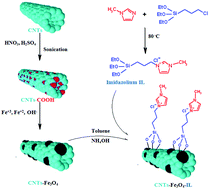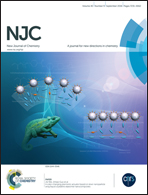Heterogenization of an imidazolium ionic liquid based on magnetic carbon nanotubes as a novel organocatalyst for the synthesis of 2-amino-chromenes via a microwave-assisted multicomponent strategy†
Abstract
Imidazolium ionic liquid functionalized magnetic multiwalled carbon nanotubes (CNTs–Fe3O4–IL) were synthesized and the structure, morphology and properties of nanocomposites were investigated using different characterization techniques such as FT-IR, VSM, SEM, TEM, XRD, TGA and DTA. In order to synthesize CNT–Fe3O4–IL, magnetite supported on CNTs (CNT–Fe3O4) was modified with 1-methyl-3-(3-trimethoxysilylpropyl)-1H-imidazol-3-ium chloride. This nanocomposite was found to be an efficient organocatalyst for the synthesis of 2-amino-chromenes via a microwave-assisted multicomponent strategy in aqueous media. The attractive features of this simple method include easy isolation of products, milder and cleaner reaction conditions, higher yields and purity of the product and an easier work-up procedure. This heterogeneous catalyst was easily separated by simply applying an external magnetic field and the recyclable organocatalyst was reused several times without any significant loss of activity. A combination of the advantages of ionic liquids and magnetic solid support nanomaterials provides an environmentally benign procedure for carrying out catalytic processes.


 Please wait while we load your content...
Please wait while we load your content...